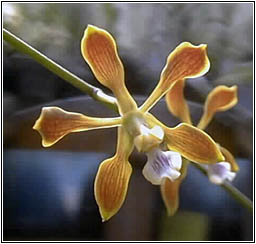 Encyclia chaipasensis |
The group of plants covered in this paper are within the subtribe Laeliinae. They belong to a group of species that at one time used to be classified as Epidendrum and latter as Encyclia. Currently this old sense of Encyclia has been divided into other genera. This talk covers the physical characteristics of some of proposed genera, with pictures illustrating these characteristics and lots of photographs of species to emphasize the similarities and differences. Epidendrum are reed stem plants with little or no pseudobulb, and a column that is fused to the lip its entire length forming a tube and their fruits are round. Encyclia. Encyclia has heteroblastic round pseudobulbs (enlarged at only one internode), their leaves are stiff, there is no sheath in evidence on the inflorescence, and their fruits are oval or circular in cross section, and most notably the lip is free of the column, not fused like Epidendrum, and there are no teeth at apex of column surrounding the anther. Many species that were originally placed into Encyclia, and yet Encyclia, in its original sense, has many traits which made the “fit” uncomfortable. |
The group of plants covered in this talk are within the subtribe Laeliinae. They belong to a group of species that at one time used to be classified as Epidendrum and later as Encyclia.
Currently this old sense of Encyclia has
been divided into other genera. This paper covers the physical characteristic s of some of proposed genera, with pictures illustrating these characteristics and lots of photographs of species to emphasize the similarities and differences. Epidendrum are reed stem plants with little or no pseudobulb, and a column that is fused to the lip its entire length forming a tube and their fruits are round. Encyclia has heteroblastic round pseudobulbs (enlarged at only one internode), their leaves are stiff, there is no sheath in evidence on the inflorescence, and their fruits are oval or circular in cross section, and most notably the lip is free of the column, not fused like Epidendrum, and there are no teeth at apex of column surrounding the anther. Many species that were originally placed into Encyclia, and yet Encyclia, in its original sense, has many traits which made the “fit” uncomfortable. In 1998, Higgins separated a group of species from Encyclia, placing them into Prosthechea. He defined Prosthechea as having pseudobulbs that are slightly flattened, homoblastic (enlarged over several nodes), leaves that are not stiff but flexible. They have an inflorescence that emerges with a spathe from the apex of the pseudobulb. Their columns are partially fused basally to about mid column length with the lip of the flower, and the column is flattened with teeth at its apex. They have seed pods that are triangular or winged. Withner & Harding took the species of Prosthechea sensu Higgins and divided them into more clearly defined genera. |
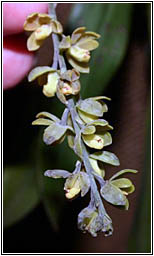 |
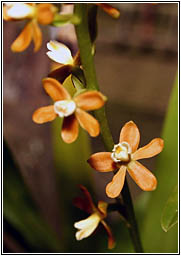 |
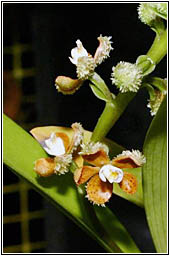 |
Prosthechea glauca |
Prosthechea ochraeca |
Prosthechea guttata |
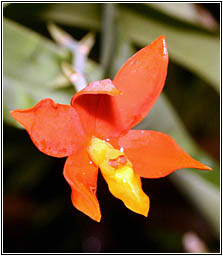 |
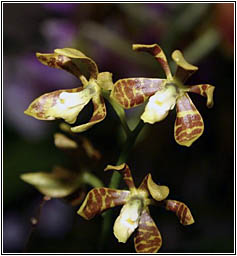 |
Prosthechea vittelina |
Prosthechea boothii |
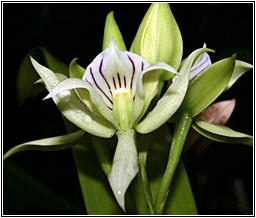 |
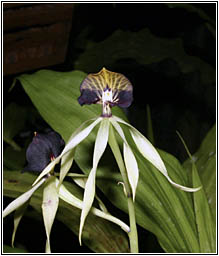 |
Anacheilium from tropical and subtropical America, have non-resupinate flowers and the column has teeth that are equal in size. |
Anacheilium chacaoense |
Anacheilium cochleata |
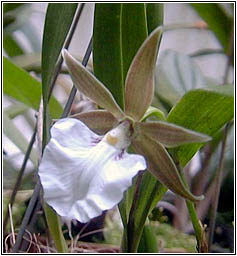 |
Pollardia includes species that are from drier climates of Mexico and Central
America with one species found in South America. The small resupinate flowers
resupinate are colorful, and fairly large for the size of plant. The column
has teeth at its apex that are equal in size. |
Pollardia ghiesbrieghtiana |
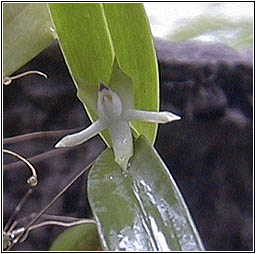 |
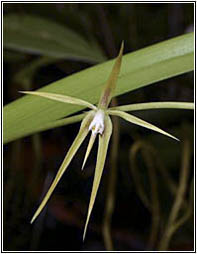 |
Hormidium from tropical and subtropical America, have a column midtooth
that is beak like. These are small plants with foliage that resembles beads
on a strand. |
Hormidium pygmeum |
Hormidium rhyncophorum |
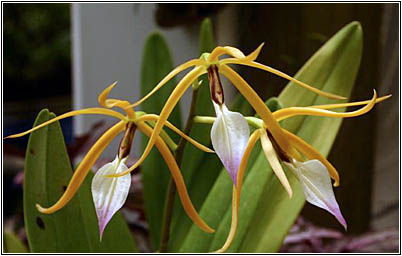 |
Panarica, mostly from Central America, have flowers with three lobed
lips, the median lobe is largest and sharply pointed. The column has large lateral
teeth and longer fimbriate median tooth. |
Panarica brassavolae |
Those that didn’t fit into other genera remained in Prosthechea, defined
as have a longer claw (isthmus) at the base of the lip before the lateral lip
lobes attach. This group of species feel can be probably divided into up to
three more genera as the shape of the flowers are so diverse, but they do fall
into certain patterns. Guy Chiron has also been working with this group and as come up with some of the same conclusions the Withner & Harding reached. He published these in 2003 with Casto. He based his studies on morphology. Prosthechea sub-genus Prosthechea Chiron & Casto is composed of P. glauca and P. squamata (Prosthechea sensu Withner & Harding) Prosthechea sub-genus Osmophytum Chiron & Casto has the unlobed Anacheilium species (Anacheilium sensu Withner & Harding) Prosthechea sub-genus Equiloba Chiron & Casto has the three lobed Anacheilium species (Anacheilium sensu Withner & Harding) Prosthechea sub-genus Hormidium Chiron & Castro include grammatoglossa in the same grouping of species as Hormidium sensu Withner & Harding. Chiron & Castro also coin a new genus, Pseudoencyclia, which combines the some of the species of Pollardia, Panarica and some of those listed in Prosthechea. Unfortunately Pseudoencyclia was published by Chiron, in November 2003, making the correct name for Pollardia Withner & Harding, based on name priority, Pseudoencyclia. Chiron uses Epidendrum michuacanum as his type species for this genus, which has many characteristics the other species contained within Pseudoencyclia/ Pollardia don’t possess; it may be with time E. michuacanum and a few others are segregated out from this group and the name Pollardia would become valid once again. Many of these species are ones that many people already have in their collections. They are plants that are relatively easy to grow, bloom readily, and are disease and pest resistant. The fact that most of these species have blooms that last a relatively long time and often fragrant should make them appealing to enthusiasts. My goal in completing this book was to create a compilation that helps put names on plants, and it is hoped that growers will feel compelled to collect and grow some of the rarer ones of this group. |
Any
kind of reproduction (print, digital or anyone)
of any type of material of this site: texts,
layout, photos, images and others - is strictly forbidden without previous written permission of the authors. Any solicitation or information by the e-mail:bo@sergioaraujo.com |